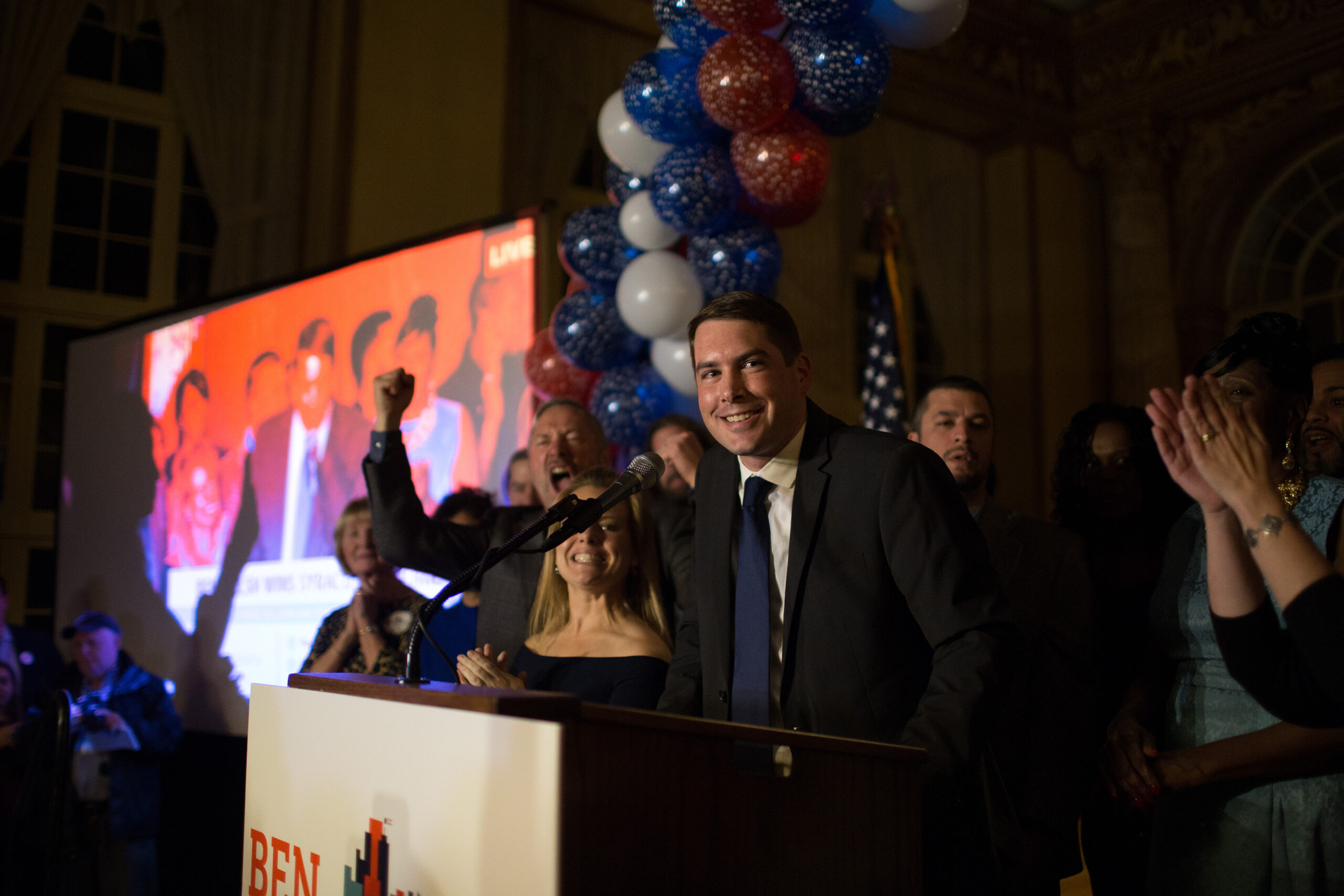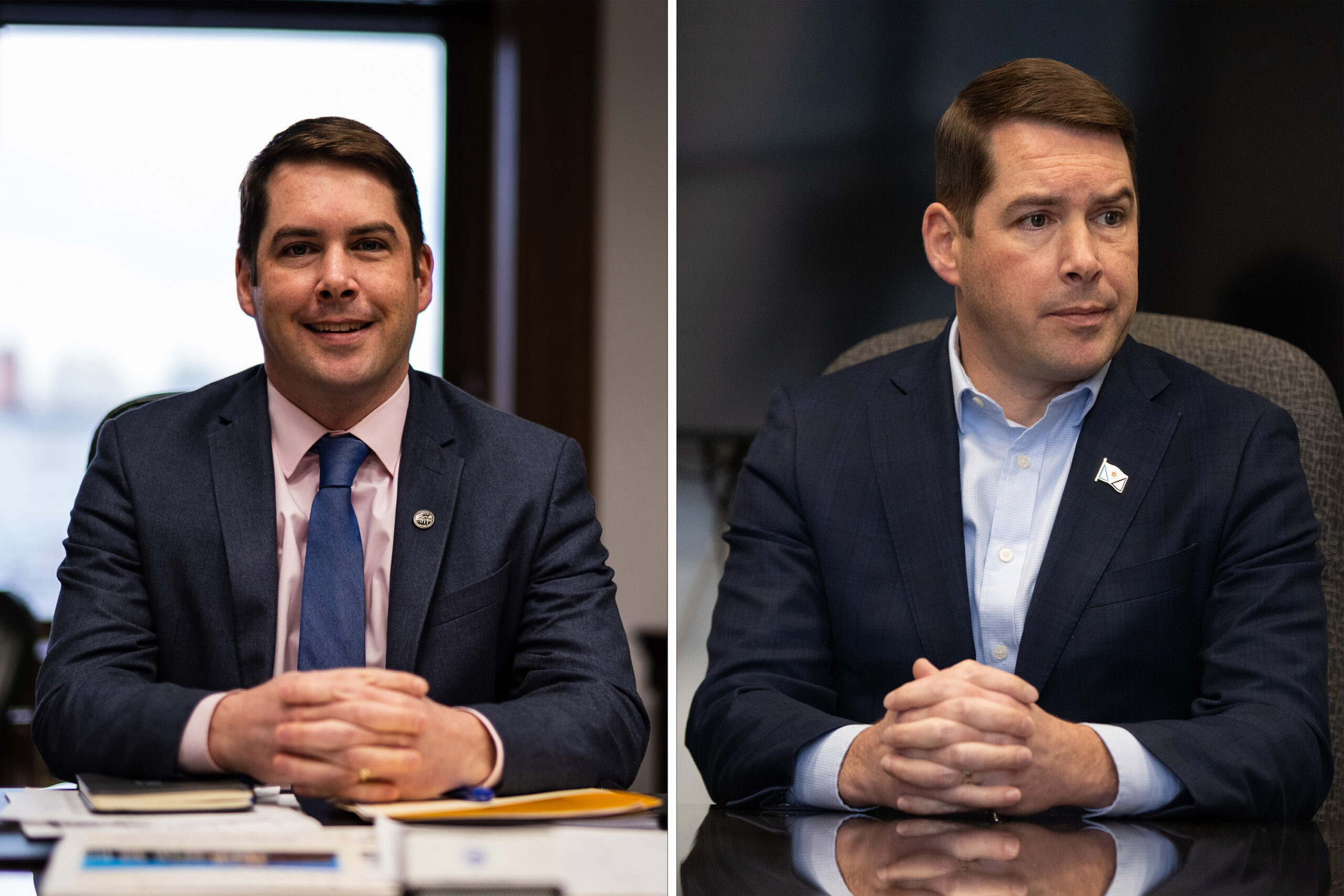Outgoing Mayor Ben Walsh speaks to 8 years of growth, ambition and investment

“I want to be viewed as someone that tried to do the right thing for the right reasons.” As he prepares to pass the baton to Mayor-elect Sharon Owens, Mayor Ben Walsh reflects on his independence, successes and shortcomings. Brycen Pace | Senior Staff Photographer
Get the latest Syracuse news delivered right to your inbox.
Subscribe to our newsletter here.
Syracuse Mayor Ben Walsh grew up surrounded by elected officials.
His grandfather, William F. Walsh, was the city’s Mayor from 1961 to 1969 and served in the United States House of Representatives for four years. His father James T. Walsh was a member of Congress for 20 years. Both served as Republicans.
But at 18 years old, Walsh registered as an independent voter in what he called an act of “youthful defiance.”
“If I was going to put myself out there, I needed to do it in a way that was authentic and sincere, and for me,” Walsh said. “That was maintaining my independence.”
He’s never affiliated with any political party and ran his mayoral campaign on an independent bid, eventually becoming Syracuse’s first independent mayor in 2018.

Josh Shub-Seltzer | Daily Orange File Photo
Walsh celebrates supporters after being elected in November 2017, becoming Syracuse’s first independent mayor.
Despite their party differences, Walsh attributes many aspects of his leadership style to his father and grandfather. He said both men were “humble public servants” who weren’t interested in “grabbing headlines,” but rather focused on leading and serving.
“I would not be doing this work if not for those two men,” Walsh said. “I learned those leadership traits, first and foremost, from them.”
Walsh said working under former Mayor Stephanie Miner, despite not having much “tolerance” for politics, is what helped him find his passion for local politics and make the run for mayor.
First taking office in 2018 and facing reelection in 2021, Walsh led the city through a global pandemic and three presidential administrations. As his term limit approaches in December, he reflects on positive moments throughout his tenure, his shortcomings and looks to the city’s future leadership under current deputy mayor and mayor-elect Sharon Owens.
“If nothing else, I want to be viewed as someone that tried to do the right thing for the right reasons,” Walsh said. “That I was an honest, dedicated public servant who moved this city forward, and I certainly believe I’ve accomplished that, and I hope others do as well.”
Serving as mayor for eight years, Walsh said he’s tried to take an “understated approach” that focuses on serving the community effectively and working collaboratively.
Compared to 2018, Walsh said the city is in a stronger position across “most metrics.” As an alum of Syracuse University’s Maxwell School of Citizenship and Public Affairs, he said his terms have meant fulfilling his “Athenian Oath” and leaving the city better than he found it.
“We’ve implemented these changes to try to ensure that these changes are systemic, so it doesn’t necessarily matter who’s sitting in the mayor’s seat,” Walsh said. “These are things that are being baked into city government.”
Several of his projects and initiatives have brought significant improvement to the city, while others have fallen short of expectations. His tenure oversaw the COVID-19 pandemic in 2020 and the “unprecedented” years after.
Walsh also oversaw notable progress in the deconstruction of the I-81 viaduct, attracted capital investment and launched infrastructure improvements.
City officials and nonprofit leaders alike describe Walsh’s eight years in office as a period defined by “growth,” ambition and investment in the city.
“We became a more resilient city and community because of it,” Jennifer Tifft, the city’s director of strategic initiatives, said. “The administration proved a good example of how to make lemonade from lemons.”
Promoting an inclusive economy
Throughout his tenure, Walsh left a notable impact on the city’s economy — from tech-based initiatives to bolstering small businesses.
Walsh said one of his biggest accomplishments was increasing the amount of money in city reserves from $50 million to over $130 million, maintaining Syracuse’s A1 bond rating, a credit score that assesses a city’s financial stability.

Dan Lyon | Daily Orange File Photo, Leonardo Eriman | Photo Editor
Walsh meets with The Daily Orange in 2019, in the middle of his first term and in 2025, at the end of his tenure.
Robert Simpson, president of CenterState CEO, defines the Walsh administration as “dynamic” and “interesting,” highlighting Walsh’s commitment to rebuilding a post-industrial economy.
“If you look around Syracuse right now, at the end of those eight years, you see a lot of cranes in the sky. You see a lot of dynamic and exciting things happening around the city,” Simpson said. “The mayor deserves a tremendous amount of credit for helping to operationalize that pivot that we’ve been trying to make for a long time.”
Nonprofit CenterState CEO acts as the city’s chamber of commerce, playing a pinnacle role in implementing one of the Walsh administration’s largest undertakings — Syracuse Surge. Launched in 2019, the project aims to build an inclusive economy and make the city a hub for technology and digital infrastructure.
Aspects of Surge include socioeconomic initiatives that provide affordable internet access, financial support and resources to Black, Indigenous and people of color-owned tech startups and constructing the INSPYRE Innovation Hub, a $32 million facility that expands the project’s former Tech Garden.
“You’ve got hundreds of millions of dollars of investment that have been driven into a part of our community that has not seen meaningful investment in probably 50 or 60 years,” Simpson said. “There is no better proof for the tangible and physical impact of the mayor’s policies than the Syracuse Surge.”
Surge initiatives have also coincided with the introduction of Micron Technologies to the city. With plans to build a four-plant semiconductor fabrication facility in Clay, Micron expects to provide over 50,000 jobs to New York residents.
Tift said the Walsh administration made fundamental changes to city services, such as trash collection and automated traffic enforcement in school zones.
“Trash collection is probably the unsexiest thing a city does, but it’s so important,” Tift said. “There’s a reason why previous administrations didn’t necessarily want to tackle everything that we took on, because it’s just a lot of change to help people through.”
Syracuse resident and SUNY ESF professor Jacob Gedetsis said he’s noticed positive changes to the city’s downtown and surrounding neighborhoods since Walsh took office. He said he’s seen more restaurants and shops stay in the city longer.
“There’s definitely a lot more to do, a lot more restaurants, a lot more community-focused stuff going on downtown,” Gedetsis said. “There’s always been major anchors, but it’s really great to see an expansion of some of those businesses and an expansion of what there is to do downtown.”
A self-proclaimed “Cleveland transplant,” Gedetsis said he’s lived in Syracuse for the past 10 years, even buying a house in the city due to its “hopeful” atmosphere.
“Not only does Syracuse need you to be here, it wants you to be here,” Gedetsis said. “It feels like a really great place for me to grow as a young person and invest in.”
But Walsh’s developments haven’t come without their challenges.
Despite a consistent A1 bond rating by Moody’s Investor Service, the Walsh administration has faced budget cuts from the Common Council, claiming city spending has gone too far.
The cuts affect park maintenance, trash pickup frequency and public safety programs, which many residents claim disproportionately affect low-income neighborhoods. Walsh said the funds were a significant liability but eventually proved a significant strength for the administration.
“We’re really proud of the kind of ways in which we’ve impacted people’s quality of life,” Walsh said.
Movements in housing and infrastructure
For Walsh, it’s the “little things” his administration has been able to do that improve residents’ quality of life.
Michael Collins, Syracuse commissioner of neighborhood and business development, said Walsh’s tenure marks one of the “most proactive” administrations that has tackled housing in a rust belt city.
“He’s the housing mayor of this century, or at least of the last 40 to 45 years or so,” Collins said. “We’re seeing housing development in all quadrants of the city. It’s not just all concentrated in one particular area.”
Collins said Walsh’s initiative, combating the city’s housing crisis through both development and improved code enforcement, allows more people to live in better-quality homes.
Median home prices in Syracuse have increased more than 5.9% since 2024 and more than doubled compared to 2017, according to a Zillow Housing Market review. However, housing affordability remains challenging for low-income families, while income rates have plateaued in comparison.
The mayor’s housing strategy project, launched in 2024, uses data from a housing survey that found one-third of Syracuse homes show signs of distress or deferred maintenance, and the cost to remediate these problems would be between $300 million and $1.5 billion.
“Housing is something that in 2018, we know we need, and in 2025 is really viewed as critical,” Walsh said.
From the findings, the housing strategy outlines a framework to restore the city’s residential infrastructure by 2050, including working in neighborhood “clusters” of 30 to 50 blocks and addressing Syracuse’s housing market and affordability gap.
Much of this involves working with already existing and vacant properties, which Collins said is at the heart of improving citizens’ quality of life.
“It’s an increase in the quality of the properties that already exist,” Collins said. “That’s been tremendous for people who are living in the existing housing that we have.”
Within the housing strategy is the “Housing Promise,” which states that 2,500 new quality housing units will be close to completion by the end of 2025. As of November, Collins said he’s confident the city is approaching that point.
“We have seen a resurgence of Syracuse under Mayor Walsh,” Collins said. “And you can’t have a resurgence and leave out a major component of society: how we live.”

Bridget Slomian | Daily Orange File Photo
Ben and his wife Lindsay Walsh attend an event together in 2019.
Walsh said there’s still work to be done. As the Syracuse Housing Authority’s East Adams project broke ground in October after its launch in 2015, Walsh said housing needs to become a priority for the city in the coming years.
“There’s a lot of housing that’s under construction and in the pipeline, but we need more,” Walsh said. “Some of the major housing projects that we’ve tried to push haven’t moved as quickly as I would have liked.”
The Walsh administration faced challenges in securing capital investments and addressing suppressed property values while rents face concurrent growth.
“We need to make sure we are engaged with our community so that we’re getting the feedback from them on what they want and what they need,” Collins said. “A lot of people will go ‘But they didn’t do this, and they didn’t do that,’ and there’ll be a lot of valid points that are made. It’s still an amazing success in every way.”
Tackling crime
Walsh said he’s proud of the improvements his administration made to the Syracuse Police Department. Reflecting on his tenure, however, he said he ultimately didn’t meet his goal of increasing the number of police officers.
In his first executive order, Walsh outlined 16 actions to increase police transparency and accountability, strengthening police-community relations. But the push for police reform that followed the death of George Floyd in 2020 discouraged many from joining the police force, he said.
“There’s just a much smaller pool now of people that want to be police officers,” Walsh said. “We’ve been very aggressive in tapping that pool, but we haven’t been able to do it at a rate that’s been able to keep up with retirements.”
Crime rates today are similar to those at the beginning of Walsh’s term in 2018. In 2017, FBI Uniform Crime Reporting data reported 705.25 crimes per 100,000 residents, increasing to 765.28 per 100,000 residents in 2024.
The Walsh administration has touted the drop in crime since COVID-19, when crime decreased by 11.3% in 2025, including a 25.7% drop in violent crimes and a 7.1% drop in property crimes.
In an Oct. 23 mayoral debate, Republican candidate Tom Babilon highlighted the lack of police officers along with high crime rates and the city’s housing crisis as “failures” of the Walsh administration.
Babilion and the other candidates, Tim Rudd and Alfonso Davis, criticized Owens for her involvement in the Walsh administration, questioning her credibility for the role.
Looking forward
Walsh’s term will end in December when he will be succeeded by Owens, who will take office on Jan. 1. He said Owens has been by his side “every step of the way,” and he couldn’t have done the job without her.
Despite this, Owens has proven to be an effective leader throughout her career, Walsh said. He explained that back when he took office in 2017, it was important to evaluate what was working and not simply change things “for the sake of change.”
He expects Owens will do the same.
There’s always more work to be done, he said. In his first year, Walsh said he felt like he was “chasing a finish line” that he eventually realized didn’t exist. He said city government is never perfect, it’s a “dynamic, fluid process” and new problems constantly emerge.
He stressed the importance of being a self-reflective and self-aware leader, but also staying true to himself. Walsh said that in moments of doubt, he would remind himself to “go with (his) gut.
“Especially difficult times where you may question yourself and your abilities, during those points I would try to remind myself, and I would remind Mayor-elect Owens, that it’s who you are that has gotten you to this point,” Walsh said.
He said Owens has different strengths and different ideas, and that it’s necessary for any mayor to make their own “imprint” on the city.
While it’s unclear what’s to come for Walsh after leaving office, he plans to remain committed to public service. Walsh said he’s open to working in several different capacities, even outside of government.
“Syracuse is home, and I expect it to be home in the future. I’m looking for a new way to serve and to help people,” Walsh said. “I expect to continue to serve the community for many years to come.”





